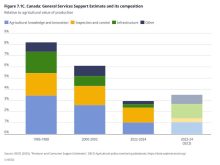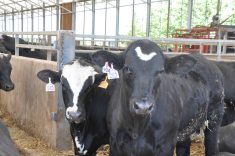This isn’t going to be one of those springs where you can stroll into your local ag retailer and be confident you’ll be leaving with everything you need.
Supply chain issues of all stripes have kept inventories of all kinds across the country depleted, even as spring approaches.
The list of ag products facing supply issues is long, and growing longer. Both crop protection products and fertilizer are caught in the net, according to industry, while producers have reported issues getting parts or certain feeds. Seemingly random shortages, such as a shortage of ear tags in both the pork and cattle sectors, have likewise extended the feeling of widespread shortages.
“We are concerned about the ongoing supply chain issues that will be facing Manitoba farmers this spring,” said Bill Campbell, president of the Keystone Agricultural Producers.
His own retailer has warned that crop protection products for a pre-seed burn-off may be thinner on the ground than usual, he said.
Why it matters: Global disruption, a supply chain ravaged by COVID-19 stresses and transportation shortages are among the reasons cited for the difficulties in keeping ag products on the shelves.
In a Feb. 1 release, crop protection company Adama urged producers to be more deliberate with planning their input supply this spring.
“We want producers to better understand supply chain interruptions and how they will impact individual farms,” general manager Cornie Thiessen said. “Our message is simple: Do what is agronomically right by planning ahead and have discussions with your retailers earlier than normal.”
It may also be time to shop around to different retailers or source from multiple businesses, Thiessen said.
“Farmers will need to be careful here,” he said. “Someone may take their order and even their money, but will they be able to fulfil an order? Suppliers may not be able to get product to retailers, and subsequently to farmers, in time.”
Glyphosate is among the products of concern. On top of a strained manufacturing and shipping environment being felt across industries, Bayer in mid-February announced a “force majeure” event (unforeseen events triggering what might be known more colloquially as an “act of God” clause) that would temporarily disrupt shipments of Roundup.
A letter, distributed to retailers by Bayer’s global head for active ingredient manufacturing, Udo Schneider, noted issues with one of the company’s ingredient manufacturers.
A “key raw material supplier experienced a mechanical failure in its manufacturing plant which leads to a substantial reduction in production rates,” and would take an estimated three months to address, the letter said.
A representative of the company’s Canadian branch later cited Bayer’s efforts to limit the impact, including stocking up on “additional materials,” Glacier FarmMedia reported.
Ray Redfern of Redferns Farm Service in Brandon is well aware of the looming issues. While it’s not yet clear how the Bayer announcement might impact his business, he said that his company made its orders earlier than typical — hopefully reflected in their place in line. He has also not yet received notice from any manufacturer that their orders will be short.
He and other retailers have also looked outside the North American market in the hopes of filling in any potential gap, he noted. Several truckloads have already arrived.
“On balance, I’m going to be optimistic for the moment that we will find a balance that looks after most of our customers,” he said.
He is, however, expecting that demand for certain products is going to run ahead of supply. As well as glyphosate, Redfern tagged potential issues for other products, such as those that include Methylcyclopropene (MCP) in the mix. And while there has not yet been confirmation that existing orders will be short, Redfern noted that some companies have capped orders on some products.
“We’ll have some products that we won’t get enough of to handle the demand if the demand is normal, or especially if it was increased due to the plant populations,” he said.
As well as glyphosate, the ADAMA release noted issues with glufosinate and MCPA.
Planning it out
Producers can expect more of an intellectual mix-and-match exercise when choosing herbicide, Redfern said. Producers may well have to spend more time looking for alternate products to achieve the same chemistry, he noted — something that puts more emphasis on the relationship between farmers and their retailer.
“We expect to have to be able to spend more time to be able to understand what products would work and to try and give growers alternatives to the one that they may have chosen to use themselves.”
Unlike fertilizer, however, stocking up early on herbicide is a less viable solution.
Crop protection, Redfern stressed, should be based on actual weed plant populations and scouting in the field, and is therefore a shorter-term decision made in season.
This may, however, be a year for more attention to non-chemical weed control.
More emphasis on things like seeding rates and crop competition may help set the producer up for success, should chemical control be less available, he noted. Timing could also go a long way to setting producers up for success, Redfern said.
He echoed the message put out annually by provincial weed specialists, who urge producers to tend to their weeds early, when the plants are most vulnerable and easy to spray out.
“This would be a year to try and make sure that you do all of those things to mitigate the weed population,” Redfern said.
It may also be the year for breaking with the company program, the Adama release suggested. Thiessen urged producers to prioritize agronomics over potential product discounts.
Clock ticking on decisions
Those who have not already taken delivery of their fertilizer may be in for a similarly tough time.
Fertilizer supply has been a topic of concern, and a source of several challenges for his company, Redfern said. As well as issues sourcing the product, the company has had to stockpile more than its typical stored supply.
Some producers are balking at the price of fertilizer, which has increased by an order of magnitude since last year, he also said.
While some farms weathered last year’s drought better than others, bolstered by high grain prices, Redfern noted that cash flow or credit issues have made some producers reluctant to lock orders in.
“We think that part of that is because usually booking means that we want to say, well if you want to lock in a price, we need more than just to say, ‘I’d like it in the spring,’” he said. “We need to have a commitment and in most cases it’s either a percentage or its purchase price. There’s a significant number of growers who didn’t have the biggest crop last year and so cash flow and availability of cash is limited.”
Those producers may be in for a rude awakening when it comes to last-minute fertilizer purchases.
While his company says it will try to accommodate farm plans, Redfern also warned that if supply issues limit availability, much like fertilizer did last fall, the company would have to prioritize orders that had been booked earlier.
Likewise, he warned against waiting in the hopes that urea prices might drop.
“Our view is that they won’t likely,” he said. “In fact, we would say that there’s every likelihood the longer the growers delay this and the more pressure they put on the system to respond, the more likely the price is to go up.”
In short, he argued, this is the year for early decisions and, if possible, an effort to store part or all of the fertilizer order on farm.
Campbell, meanwhile, also stressed the need for an early brainstorming session with the farmer’s chosen retailer, “having that knowledge of, will there be product there when I get to seeding or do I need to store some? What does it look like? What does the seeding intentions in North America look like and all of those things that they will have a better handle on than the individual farmer.”
“Relationships matter,” he said. “Make sure you have that conversation early. Go over your plans. Maybe have options. Look at all of the flexibility that you may have.”
















